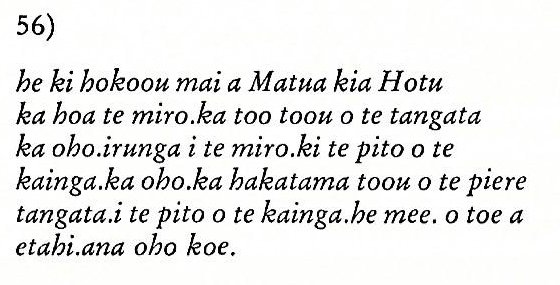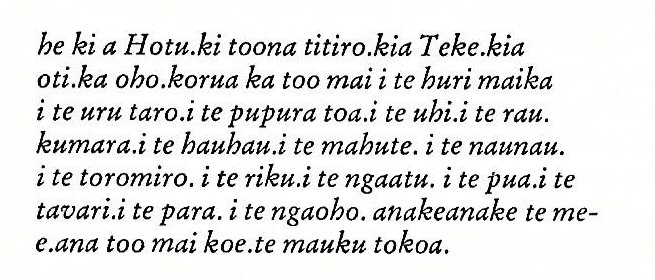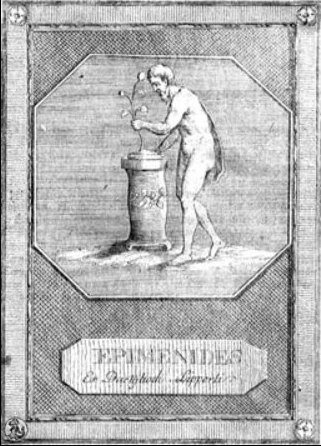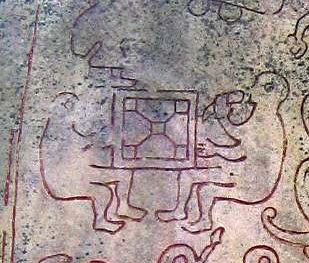Once again. For 5 months (= 5 * 26 = 130 days) Ira had been searching for a new
land and he had not (yet) returned.


|
he tuu ki te tau i a
Hotu.he ki a Matua |
Hotu's time
came [he tuu ki te tau i a Hotu], and Matua
spoke to Hotu, 'Put the canoe (miro) into the
water and sail to Te Pito O Te Kainga. For five
months Ira has been searching for the land. Ira went
away and did not return [hoki mai nei a Ira].' |
|
kia Hotu.ka
hoa te miro
ki haho ki te tai ka |
|
oho.ki te pito o te
kainga.karima.mara(-) |
|
ma o Ira.ki tikea ana
te kainga.e Ira.i o(-) |
|
ho era.e tae. hoki mai
nei a Ira. |
| Hoa.
1. Master, owner; tagata hoa papaku,
owner or relative of a dead; hoa manu, 'bird
master', that is, he who received the first egg at
the annual festivals in Orongo; he to'o
mai e te hoa manu i te mamari ki toona rima, he
ma'u, he hoko, the 'bird master' receives the
egg in his hand and carries it, dancing. 2.Friend,
companion: e ga hoa ê! 3. To cast away, to throw
away, to abandon, perhaps also to
expel. 4. To confess a sin; he hoa i te
ta'u: term used of a category of rongorongo
boards (see ta'u). Vanaga. 1. Friend;
repa hoa, friend (male), comrade, companion,
fellow; to confide; repa hoa titika, faithful
friend; garu hoa, friend (either sex); uha
hoa, friend (female); hoa kona, native T.
2. To abandon, to debark, to cast, to launch, to
anchor, to let go, to give up, to reject, to
repudiate, to suppress, to cut off, to jerk out, to
proscribe, to reprove; hoahoa, to upset, to
destroy. Churchill. Haho. Outside. Vanaga.
Hahoa (ha causative, hoa) to
cut, to wound, to hurt. PS Mgv.: tahoa, to
make papyrus by beating. Sa.: foa, to chip,
to break. To.: foa, to crack, to make an
opening. Fu.: foa, to dig, the rent in a mat.
Underlying the Nuclear Polynesian significations the
primal sense seems to be that of a hole. The
Rapanui, a causative, is a clear derivative in
the cutting sense; wound and hurt are secondary
withing this language. The Mangarevan composite
means 'to beat until holes appear', which is a
distinctive character of the beaten bast of the
paper mulberry in the condition in which it is ready
for employment in making tapa. Churchill. |
|
E:56 → Alcyone
... another Alcyone, daughter of
Pleione, 'Queen of Sailing', by the oak-hero Atlas,
was the mystical leader of the seven Pleiads. The
heliacal rising of the Pleiads in May marked the
beginning of the navigational year; their setting
marked its end when (as Pliny notices in a passage
about the halcyon) a remarkably cold North wind
blows ... |
|
he ki hokoou mai a
Matua kia Hotu |
Then Matua
said to Hotu, 'Launch the canoe [ka hoa te miro],
gather [ka too toou] the people, and sail on
board the canoe [ka oho.irunga i te miro] to
Te Pito O Te Kainga. Sail on [ka oho] and
let children be born [ka hakatama toou] by the many in Te Pito O Te
Kainga (i.e., the number of your subjects will
increase in the new homeland).
Not one thing [he mee. o toe a etahi]
shall remain behind (i.e., everything that is needed
will be taken along) when you leave [ana oho koe]!' |
|
ka hoa te miro.ka too
toou o te tangata |
|
ka oho.irunga i te
miro.ki te pito o te |
|
kainga.ka oho.ka
hakatama toou o te
piere |
|
tangata.i te pito o te
kainga.he mee. o toe a |
|
etahi.ana oho koe. |
|
Tama. 1.
Shoot (of plant), tama miro, tree shoot;
tama tôa, shoot of sugarcane. 2. Poles, sticks,
rods of a frame. 3. Sun rays. 4. Group of people
travelling in formation. 5. To listen attentively
(with ear, tariga, as subject, e.g. he
tama te tariga); e-tama rivariva tokorua
tariga ki taaku kî, listen carefully to my
words. Tamahahine, female. Tamahine (=
tamahahine), female, when speaking of
chickens: moa tamahine, hen. Tamâroa,
male. Vanaga. 1. Child. P Pau.: tama riki,
child. Mgv.: tama, son, daughter, applied at
any age. Mq.: tama, son, child, young of
animals. Ta.: tama, child. Tamaahine (tama
1 - ahine), daughter, female. Tamaiti,
child P Mq.: temeiti, temeii, young
person. Ta.: tamaiti, child. Tamaroa,
boy, male. P Mgv.: tamaroa, boy, man, male.
Mq.: tamaóa, boy. Ta.: tamaroa, id. 2.
To align. Churchill. In the Polynesian this [tama
na, father in the Efaté language] is
distinguished from táma child by the accent
tamā or by the
addition of a final syllable which automatically
secures the same incidence of the accent,
tamái,
tamana ...
Churchill 2.

Kai toe kai tohe etahi, omitted nothing
whatsoever (E:13). |
|
he ki a Hotu.ki toona
titiro.kia Teke.kia |
Hotu said
to his assistants [ki toona titiro] Teke and
Oti, 'Go and take banana shoots, taro seedlings,
sections of sugarcane to be planted, yam roots,
sweet potatoes with leaves (? rau kumaru),
hauhau trees, paper mulberry trees, sandalwood
trees, toromiro trees, ferns (riku),
rushes, yellow roots, tavari plants, moss (para),
and ngaoho plats. Take all of these things [anakenake
te mee] (i.e., all varieties of plants) and also
grass [te mauku tokoa]!' |
|
oti.ka oho.korua ka too
mai i te huri maika |
|
i te uru taro.i
tepupura toa.i te uhi.i te rau. |
|
kumara.i te hauhau.i te
mahute. i te naunau. |
|
i te toromiro. i te
riku.i te ngaatu. i te pua.i te |
|
tavari.i te para. i te
ngaoho. anakeanake te me(-) |
|
e.ana too mai koe.te
mauku tokoa. |
|
Tiro. Mgv.:
Spots on linen. Ta.: tiro, to mark. Mq.:
tiotioa, blotched, covered with white spots.
Titiro, to admire. P Ma.: tiro, to gaze
at. Churchill. Vi.: tiro, siro,
sisiro, to descend, to go down a steep or hill.
Churchill 2. Pua mouku, grass. Churchill.
Uku koku
is the name of a dark type of grass, which in
earlier times was used to make hats. Barthel 2. |
... What happens after (or happened, or will
happen sometime, for this myth is written in the future tense),
is told in the Völuspa, but it is also amplified in Snorri's
Gylfaginning (53), a tale of a strange encounter of King
Gylfi with the Aesir themselves, disguised as men, who do not
reveal their identity but are willing to answer questions: 'What
happens when the whole world has burned up, the gods are dead,
and all of mankind is gone? You have said earlier, that each
human being would go on living in this or that world.' So it is,
goes the answer, there are several worlds for the good and the
bad. Then Gylfi asks: 'Shall any gods be alive, and shall there
be something of earth and heaven?' And the answer is: 'The earth
rises up from the sea again, and is green and beautiful and
things grow without sowing. Vidar and Vali are alive, for
neither the sea nor the flames of Surt have hurt them and they
dwell on the Eddyfield, where once stood Asgard. There come also
the sons of Thor, Modi and Magni, and bring along his
hammer. There come also Balder and Hoder from the other world.
All sit down and converse together. They rehearse their runes
and talk of events of old days. Then they find in the grass the
golden tablets that the Aesir once played with ...

|
Hetu erua |
tagata
rere ki te ragi |
|
Hetu 1. To (make)
sound; figuratively:
famous, renowned. 2. To crumble into embers (of a
bonfire). Hetu'u. Star,
planet; hetu'u popohaga
morning star; hetu'u ahiahi evening star; hetu'u viri
meteorite. Vanaga Hetu 1. Star (heetuu);
hetu rere, meteor; hetu pupura,
planet. P Pau.: hetu, star. Mgv.:
etu, id. Mq.: fetu, hetu,
id. Ta.: fetu, fetia, id. The
alternative form fetia in Tahiti, now
the only one in common use, need not be
regarded as an anomaly in mutation. It seems
to derive from Paumotu fetika, a
planet. Its introduction into Tahiti is due
to the fashion of accepting Paumotu vocables
which arose when the house of Pomare
came into power. 2. Capital letter (? he
tu). 3. To amuse. 4. To stamp the feet.
Hetuhetu, to calk, to strike the
water. Hetuke, sea urchin. Churchill. |
 |
 |
 |
|
Cb8-1 (172 → solstice) |
Cb8-2 (565 = 392 + 173) |
Cb8-3 (442 + 130 - 6 = 566) |
|
CLOSE TO
THE FULL MOON: |
|
APAMI-ATSA
(Child of Waters) = θ Virginis,
ψ
Hydrae (198.5),
DIADEM =
α
Com. Ber.
(198.9) |
AL DAFĪRAH (Tuft) = β Com. Ber.
(199.4)
*158.0 = *199.4 - *41.4 |
σ Virginis (200.4)
*159.0 = *200.4 - *41.4 |
|
...
Apami-Atsa ('Child of Waters', θ
Virginis) at 13h maybe should be contrasted
with Apam Napat ('Grandson of
Waters') ... θ is
on the front of the garment, below the
girdle ... Moderns have no name for it, but
in the Surya Siddhanta it was
Apami-Atsa, the Child of the Waters ...
Apam Napat is an eminent
figure of the Indo-Iranian pantheon. In
Hinduism, Apām Napāt is the god of
fresh water, such as in rivers and lakes. In
Zoroastrianism, Apąm Napāt is also a
divinity of water ... Apām Napāt in
Sanskrit and Apąm Napāt in Avestan
mean 'grandson of waters' ... Sanskrit and
Avestan napāt ('grandson') are
cognate to Latin nepōs and English
nephew, but the name Apām
Napāt has also been compared to Etruscan
Nethuns and Celtic Nechtan and
Roman Neptune. In Yasht 19 of the
Avesta Apąm Napāt appears as the
Creator of mankind. Here, there is an
evident link between the glory of
sovereignty (Khvarenah) and Apąm
Napāt who protects Khvarenah as
the royal glory of Iranian kings. Apām
Napāt is sometimes, for example in
Rigveda book 2 hymn 35 verse 3, described as
a fire-god who originates in water ... The
reference to fire may have originally
referred to flames from natural gas or oil
seepages surfacing through water, as in a
fire temple at Surakhany near Baku in
Azerbaijan ... There is a conjecture that
the word 'naphtha' came (via Greek,
where it meant any sort of petroleum) from
the name 'Apampat' ...
 |
|
Oct 5 |
6 |
7 (280) |
|
'Sept 8 |
9 |
10 (253 = 280 - 27) |
|
"Aug 25 (237 = 8
* 29½ + 1) |
Hora iti 26 |
27 |
|
(PAPA O PEA) |
AHU AKAPU |
|
Here above I have moved Ahu Akapu 1
day ahead, compared to my earlier
presentations, in order to make it begin
when the Full Moon reached Cb8-3 (→ 24).
Aka. 1. Anchor: he-hoa te aka,
to drop anchor. 2. Root of certain plants
(banana tree, taro, sugar-cane). 3. To be
paralyzed by surprise. Vanaga. 1. Root;
aka totoro, to take root. P Pau., Mq.:
aka, root. Ta.: aa, id. 2.
(āka)
anchor. 3. Causative (haka).
Churchill.
The Explorers
stayed for 2 days in Ahu Akapu
and Cb8-6 (→ 48)
should therefore correspond to "September 29
when the Full Moon reached Spica. |
|
CLOSE TO
THE
SUN: |
|
April 5 (365 + 95 = 460) |
6 (96 =
80 + 16) |
7 |
|
1h (15.2)
β
Phoenicis (15.1),
υ
Phoenicis,
ι
Tucanae (15.6),
η
Ceti,
ζ
Phoenicis (15.7) |
Al Batn Al Hūt-26 (Belly of the Fish) /
Revati-28 (Prosperous) /
1-iku (Field Measure)
MIRACH
(Girdle) =
β
Andromedae,
KEUN MAN MUN (Camp's South Gate) = φ
Andromedae
(16.0),
ANUNITUM =
τ
Piscium
(16.5),
REVATI (Abundant) =
ζ
Piscium
(16.9)
REGULUS
(α Leonis) |
ν Phoenicis (17.4), κ Tucanae (17.6)
*342.0 = *383.4 - *41.4
= *159.0 + *183.0 |
|
'March 9 (68) |
10 |
11 |
|
"Febr 23 |
24 |
25 |
|
... The leap day was introduced as part of
the Julian reform. The day following the
Terminalia (February 23) was doubled,
forming the 'bis sextum - literally
'double sixth', since February 24 was 'the
sixth day before the Kalends of March' using
Roman inclusive counting (March 1 was the
'first day'). Although exceptions exist, the
first day of the bis sextum (February
24) was usually regarded as the intercalated
or 'bissextile' day since the third century.
February 29 came to be regarded as the leap
day when the Roman system of numbering days
was replaced by sequential numbering in the
late Middle Ages ... |
| te hokohuki |
te moko |
vero
hia |
tagata honui |
e
ha mata |
|
Ha. 1. Four. 2. To
breathe. Hakaha'a, to
flay, to skin. Vanaga. 1. Four. P Mgv., Mq., Ta.: ha, id.
2. To yawn, to gape. 3. To heat. 4. Hakaha,
to skin, to flay; unahi hakaha, to scale
fish. Mgv.: akaha, to take to pieces, to
take off the bark or skin, to strip the leaves
off sugarcane. 5. Mgv: ha, sacred,
prohibited. Mq.: a, a sacred spot. Sa.:
sa, id. Churchill. |
 |
 |
 |
 |
 |
|
Cb8-4 |
Cb8-5 (172 + 4) |
Cb8-6 (177 = 6 * 29½) |
Cb8-7 (392 + 178 = 570) |
Cb8-8 (1½ * 314 + 100) |
|
CLOSE TO THE
FULL MOON: |
|
γ Hydrae (201.0), ι Centauri (201.4)
*160.0 = *201.4 - *41.4 |
Al Simāk-12 (Lofty) /
Chitra-14 (Bright One) /
Horn-1 (Crocodile) /
Sa-Sha-Shirū-20
(Virgin's Girdle) /
ANA-ROTO-3 (Middle pillar)
MIZAR = ζ Ursae Majoris
(202.4),
SPICA
= α Virginis,
ALCOR
= 80 Ursae Majoris
(202.7)
SADALMELIK (α Aquarii)
*161.0 = *202.4 - *41.4 |
71 VIRGINIS
(203.6) |
no
star listed (204) |
HEZE
= ζ Virginis
(205.0),
Southern Pinwheel Galaxy = M83 Hydrae
(205.7) |
|
... Proclus
informs us that the fox star nibbles
continuously at the thong of the yoke which
holds together heaven and earth; German folklore
adds that when the fox succeeds, the world will
come to its end. This fox star is no other than
Alcor, the small star g near zeta Ursae
Majoris (in India Arundati, the common
wife of the Seven Rishis, alpha-eta Ursae
...
 |
|
Oct
8 (240 + 41) |
9 |
10 |
11 (364 - 80) |
12 (285) |
|
'Sept 11 (354 - 100) |
12 |
13
(256 = 4 * 64) |
14 |
15 |
|
"Aug
28 (240) |
HORA ITI 29 |
30
(242 = 2 * 11 * 11) |
31 |
HORA NUI 1 |
|
AHU
AKAPU |
PU PAKAKINA A IRA |
|
Paka. 1. Dry; to become dry (of
things); pakapaka, to dry out. Te paka
is also the name of the moss-covered areas,
between the small lakes of volcano Rano Kau,
through which one can pass without getting
one's feet wet. 2. To go, to depart;
he-paka-mai, to come; he-oho, he-paka,
they go away. 3. To become calm (of the
sea): ku-paka-á te tai. Pakahera,
skull, shell, cranium; pakahera puoko tagata,
human skull; pakahera pikea, shell of
crab or crayfish. Gutu pakapaka, scabbed
lips. Hau paka, fibres of the hauhau
tree, which were first soaked in water, then
dried to produce a strong thread. Moa gao
verapaka, chicken with bald neck. Ariki
Paka, certain collateral descendents of
Hotu Matu'a, who exercised religious
functions. Vanaga. 1. Crust, scab, scurf;
paka rerere, cancer; pakapaka, crust,
scabby. 2. Calm, still. 3. Intensive; vera
paka, scorching hot; marego paka,
bald; nunu paka, thin. 4. To arrive, to
come. 5. To be eager. 6. To absorb. 7. Shin T.
Pakahera, calabash, shell, jug.
Pakahia, to clot, curdle, coagulate.
Pakapaka, dry, arid, scorching hot, cooked
too much, a desert, to fade away, to roast, a
cake, active; toto pakapaka, coagulated
blood; hakapakapaka, to dry, to broil, to
toast. Pakahera pikea, shell of crab or
crayfish. Churchill.
Kinana,
s. Haw., a hen that has hatched chickens.
Sam., tina,
a mother.
Tong., tina-manu, a sow that had litter.
Tah., ti'a,
the lower part of the stomach, below the navel.
Fiji., tina,
mother; tina-tina, mother of inferior
animals. N.
Zeal., tinana, the buttocks, trunk, body.
This word, with
somewhat varying but not far separate meanings,
I am inclined to consider as related to the
Goth., kwens,
kwino, a woman; kwina-kunds and
kwineins, female; and possibly kwithus,
the womb, the stomach, if that is syncope of an
original kwinthus. Greek,
γυνη, woman
... |
|
CLOSE TO THE
SUN: |
|
April 8
no
star listed (18) |
9
ADHIL
(Garment's Train) = ξ Andromedae
(19.3),
θ
Ceti (19.7) |
10
(100)
KSORA (Knee) = δ Cassiopeiae
(20.1),
ω
Andromedae (20.6),
γ
Phoenicis (20.8) |
11 (364 - 263)
δ
Phoenicis (21.5) |
12
υ Andromedae (22.9) |
|
'March 12 |
13 |
14
(73) |
15 |
16 |
|
"Febr 26 |
27 |
28
(59) |
29 |
"March 1 |
 |
| te hokohuki - ma
te maro |
te hokohuki ma te
maro |
ka ke te manu ki
te maro |
|
Ke. 1. Other; different;
different being; hare ké, a different house;
e-ké-ro-á... e-ké-ro-á... there are some
who... and others who...; me'e ké, something
distinct, different: te puaka ina oona kuhane;
me'e ké te tagata, he hakari oona, he kuhane, an
animal has no soul; man is different, he has a body,
and a soul; matu'a ké, the other relatives.
2. Ké te kairua, person who turns up for
meals at other people's homes. 3. Used in
exclamations: hahau ké! what a cool breeze!;
hana ké! how hot! takeo ké! how cold!
Vanaga. Other, distinct, different, diverse,
otherwise; koona ke, elsewhere; tagata ke,
some one else; mea ke, contrary, distinct,
otherwise; hakake, feint, stratagem, to
feign; hagake, to act contrary. T Pau.: ke,
different. Mgv.: ke, another, other, else,
different, of partial comparative value. Mq.: ke,
é, to be different, changed, no longer the
same. Ta.: e, different, strange, other.
Churchill.E, adv. and ppr. Haw., from,
away, off, by, through, means of; also, adverbially,
something other, something strange, new; adj.
contrary, opposed, adverse, other, foreign. Sam.:
e, ppr. by, of; ese, other
different, strange.Ta., e, ppr. by,
through, from; adv. away, off; adj.
different, strange, distant; ee, strange. N.
Zeal., ke, strange, different.Malg., eze,
of, by.Greek,
έκ, έξ,
from out of, from, by, of; έκει, in that
place, opp. to ένθαδε,
in some other place than that of the speaker,
thither; έκας,
afar off. Lat., e, ex, out of, from.
Liddell and Scott (Gr.-Engl. Dict., s. v.) say: 'The
root of έτ-ερος is said to be the same as
Sanskr. ant-aras, Goth. auth-ar, Germ.
and-er, Lat. alt-er, aut, French
aut-rui, our eith-er, oth-er,
itara = alius, also in Sanskrit.'
Whatever the root of ant-aras, auth-ar,
alter, it seems to me that έκας
shows nearer kindred to
the Polynesian e, ke, ee,
ese, eze, than to forms so developed as
ant-ar, ant-ara, &c. Fornander. |
 |
 |
 |
|
Cb8-9
(180) |
Cb8-10 |
Cb8-11 |
|
CLOSE TO THE FULL
MOON: |
|
ε Centauri (206.3), κ Oct. (206.4)
*165.0 = *206.4 - *41.4 |
no star listed (207) |
τ
Bootis (208.2),
BENETNASH
(Leader of the Daughters of the Bier) =
η
Ursae Majoris
(208.5),
ν
Centauri (208.7),
μ
Centauri,
υ
Bootis (208.8) |
|
Oct 13 |
14 |
15
(288 = 12 * 24) |
|
'Sept 16 |
17 (260 = 364 -
104) |
18 (9 * 29 = 261) |
|
HORA NUI 2 |
"Sept 3
(246) |
4 (13 * 19 = 247) |
|
PU
PAKAKINA
Paka. 1. Dry; to become dry (of things);
pakapaka, to dry out. Te paka is also
the name of the moss-covered areas, between the
small lakes of volcano Rano Kau, through
which one can pass without getting one's feet wet.
2. To go, to depart; he-paka-mai, to come;
he-oho, he-paka, they go away. 3. To become calm
(of the sea): ku-paka-á te tai. Pakahera,
skull, shell, cranium; pakahera puoko tagata,
human skull; pakahera pikea, shell of crab or
crayfish. Gutu pakapaka, scabbed lips. Hau
paka, fibres of the hauhau tree, which
were first soaked in water, then dried to produce a
strong thread. Moa gao verapaka, chicken with
bald neck. Ariki Paka, certain collateral
descendents of Hotu Matu'a, who exercised
religious functions. Vanaga. 1. Crust, scab, scurf;
paka rerere, cancer; pakapaka, crust,
scabby. 2. Calm, still. 3. Intensive; vera paka,
scorching hot; marego paka, bald; nunu
paka, thin. 4. To arrive, to come. 5. To be
eager. 6. To absorb. 7. Shin T. Pakahera,
calabash, shell, jug. Pakahia, to clot,
curdle, coagulate. Pakapaka, dry, arid,
scorching hot, cooked too much, a desert, to fade
away, to roast, a cake, active; toto pakapaka,
coagulated blood; hakapakapaka, to dry, to
broil, to toast. Pakahera pikea, shell of
crab or crayfish. Churchill. |
|
CLOSE TO THE
SUN: |
|
ACHERNAR
(End of the River) =
α
Eridani
(23.3),
χ
Andromedae (23.6),
τ
Andromedae (23.9) |
ALSEIPH
(Scimitar) =
φ
Persei
(24.5),
τ
Ceti (24.7) |
no star
listed (25) |
|
April 13 → 413 = 14 * 29½ |
14
(104 = 4 * 26) |
15 |
|
'March
17 |
18 |
19 (78
= 3 * 26) |
|
"March 2 |
VAITU NUI 3 (63) |
4 (8 * 8) |
|
FEBR 8 |
9 (40
= 24 + 16) |
10 |
|
... On February 9
the Chorti Ah K'in, 'diviners', begin the
agricultural year. Both the 260-day cycle and the
solar year are used in setting dates for religious
and agricultural ceremonies, especially when those
rituals fall at the same time in both calendars. The
ceremony begins when the diviners go to a sacred
spring where they choose five stones with the proper
shape and color. These stones will mark the five
positions of the sacred cosmogram created by the
ritual. When the stones are brought back to the
ceremonial house, two diviners start the ritual by
placing the stones on a table in a careful pattern
that reproduces the schematic of the universe. At
the same time, helpers under the table replace last
year's diagram with the new one. They believe that
by placing the cosmic diagram under the base of God
at the center of the world they demonstrate that God
dominates the universe. The priests place the stones
in a very particular order. First the stone that
corresponds to the sun in the eastern, sunrise
position of summer solstice is set down; then the
stone corresponding to the western, sunset position
of the same solstice. This is followed by stones
representing the western, sunset position of the
winter solstice, then its eastern, sunrise position.
Together these four stones form a square. They sit
at the four corners of the square just as we saw in
the Creation story from the Classic period and in
the Popol Vuh. Finally, the center stone is placed
to form the ancient five-point sign modern
researchers called the quincunx ...
 |
|
DAY 23 |
24 |
25
(= 5 * 5) |

... It is well known that the Khufu
pyramid was built in order to represent the northern
hemisphere and similarly was the pyramid of the Winged
Serpent constructed to visualize the year in the north
...
|














